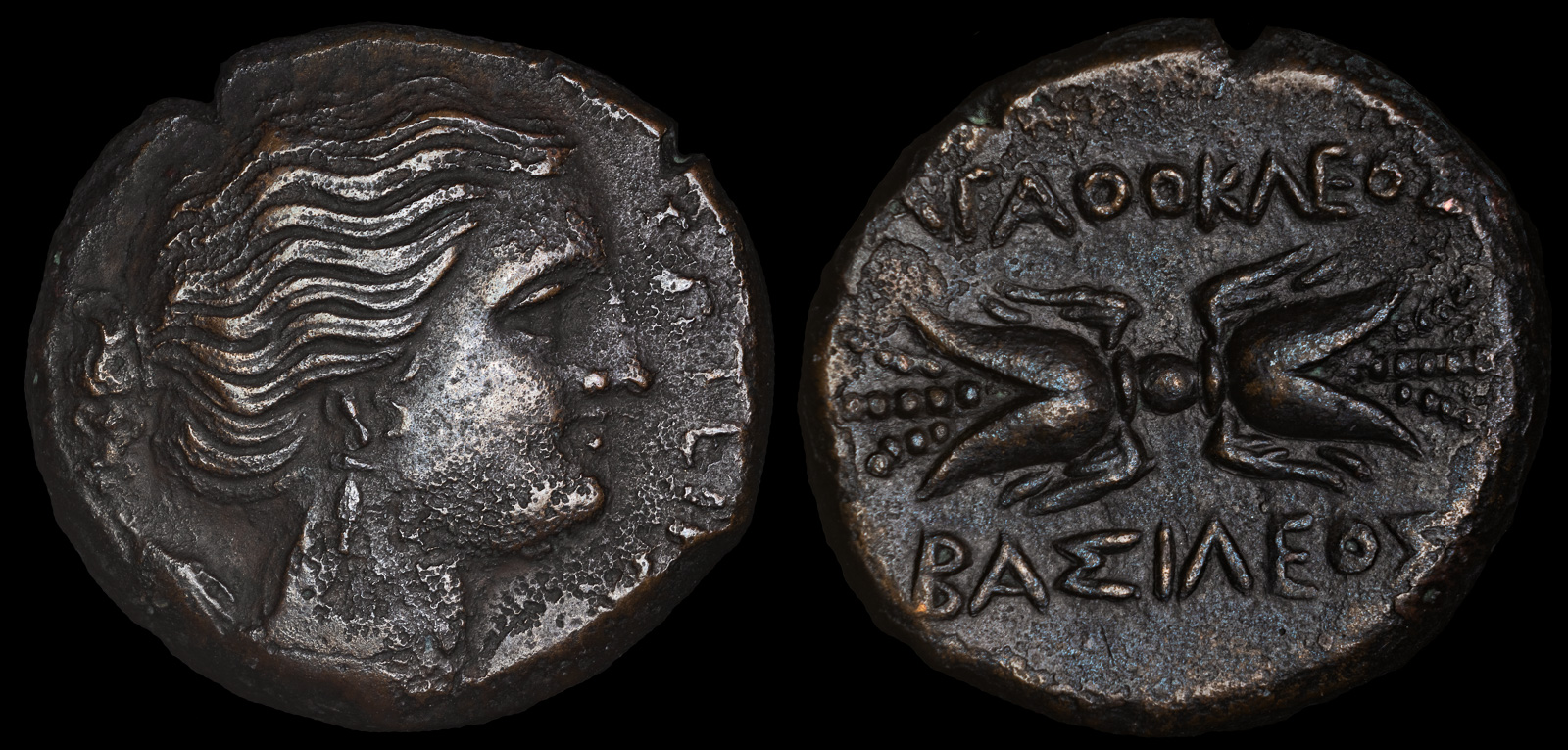
Sicily, Syracuse. Agathokles
Period 4, circa 295 BCE
Æ Litra 23mm, 8.35 gm, 1h
ΣΩTEIΡA, head of Artemis Soteria right, wearing triple-pendant earring and necklace, quiver over shoulder / AΓAΘOKΛEOΣ BAΣIΛEOS, winged thunderbolt.
Calciati II pg. 279, 142/25; SNG ANS 708; Favorito 34
Agathokles is another person that I initially didn’t include in this collection. After all, he didn’t have much to do with the Diadochi, right?
It turns out he did. First of all, he lured Ophellas to Kyrenaica with dreams of glory. Once there, he murdered him and took control of his troops, although the combined force was still not capable of winning out.
Agathokles also tangled with Kassander’s troops in Korkyra, and took that island for his own. He later bequeathed it to Pyrrhos of Epeiros, and so Agathokles had direct connections with three individuals already in this collection. On that basis, I added him.
He certainly was a colorful character, weaseling his way from being born a potter to becoming tyrant of the city. As a tyrant, he was a particularly bloodthirsty one and murdered many of the oustanding individuals of Syracuse and other cities. I’d like to think that’s why the first part of his name is scratched out on one of my coins from him. Clearly someone back then didn’t like him, since there’s little wear on either side of the coin except for the name. Given how many enemies he made, it seems likely that it was done by someone harmed.
Interestingly, before he died Agathokles put Syracuse back as a democracy. Evidently he felt no tyrant could follow his path.

Agathokles 317 -289 BCE
Syracuse Sicily
Ae Trias 22.1mm, 8.4gms
Obv: SOTEIPA; Draped bust of Artemis Soteira right with quiver over shoulder
Rev: AG AThOKLEOS BASILIEWS; Winged thunderbolt
SNG ANS 708
The above coin I find particularly interesting because it seems Agathokles’ name was scratched out. Could that have been done by someone who suffered at the tyrant’s hands?
Agathokles of Syracuse born at Thermai Himeraia.
Agathokles moves with his father, a potter, to Syracuse.
Agathokles begins his military career serving in the army of Syracuse under the leadership of Timoleon.
Agathokles marries the daughter of a wealthy Syracusan citizen, which helps him rise in social and political standing.
After years of service in the army, Agathokles gains popularity and starts to accumulate power in Syracuse, becoming involved in political conflicts.
Agathokles seizes power in Syracuse by staging a coup. He establishes himself as a tyrant, eliminating his political rivals and ending the democratic government.
Agathokles of Syracuse begins a campaign to expand his territory in Sicily. He conquers several neighboring cities, including Gela and Messana.
Agathokles of Syracuse temporarily takes Kentoripai.
Agathokles launches his expedition to North Africa, landing near Carthage. His unexpected attack catches the Carthaginians off guard, and he achieves several victories on African soil. Agathokles declares himself king of Sicily during this campaign, marking a significant shift in his ambitions.
After a prolonged campaign in North Africa and facing mounting difficulties, Agathokles abandons the African expedition.
Agathokles murders his two sons from his first wife.
Kephaloidion attacked and taken by Agathokles of Syracuse.
Agathokles formally adopts the title of King of Sicily, consolidating his rule and securing recognition from other Hellenistic rulers. He strengthens his alliances, including with Ptolemaic Egypt and other Greek states.
Kentoripai taken by Agathokles of Syracuse.
Agathokles wages a series of successful campaigns against his enemies in Sicily, reasserting his dominance over the island. He continues to fortify Syracuse and build up its naval power.
Agathokles marries his daughter Lanassa to Pyrrhos of Epeiros.
Demetrios Poliorketes marries Lanassa, the former wife of Pyrrhos and daughter of Agathokles of Syracuse.
Agathokles dies of natural causes at the age of 72. On his deathbed, he decides not to pass his power to his descendants, attempting to restore a democratic government in Syracuse.
After the death of Agathokles of Syracuse, Phintias declared himself leader of Akragas.